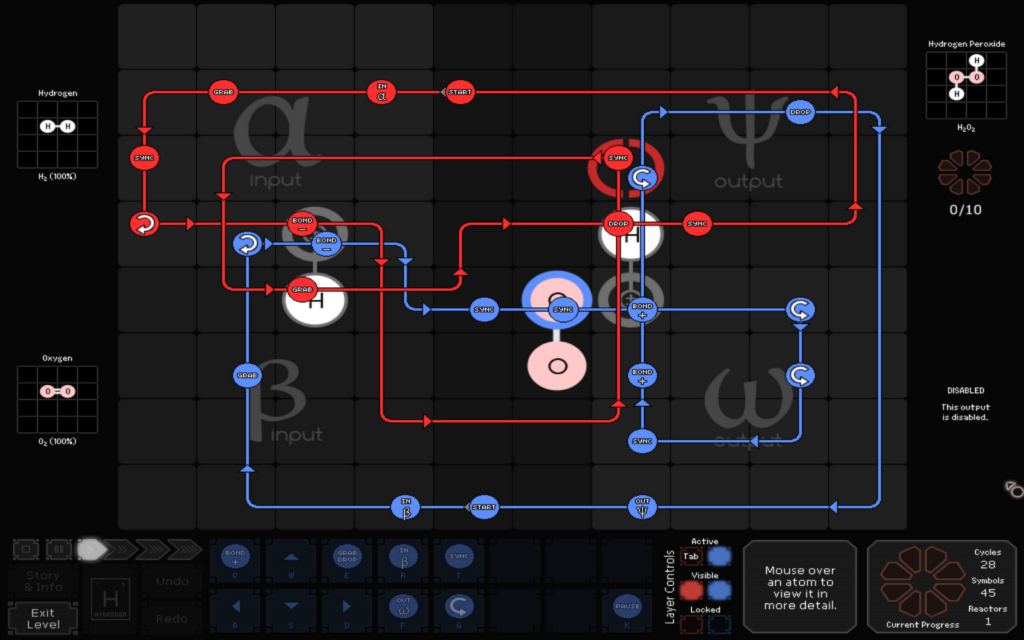If you had told me a week ago that I’d be completely and utterly addicted to a game where the player does little more than push chemical elements around from one place to another, I really, really, really wouldn’t have believed you. Alright, so SpaceChem, from Zachtronics Industries, is a bit more intricate than that – it’s set in space, for one thing, and has a very cool background story that unfolds about the life of a first-time, space-exploring chemical engineer; but all of this, while enjoyable, is really only window dressing to the core game experience.
You, as the plucky, intrepid engineer, play through a campaign that takes you from planet to planet, where you are presented with a series of objectives to complete before you can move on. Initially the campaign teaches you the tools of your trade, but after the first handful of objectives, you are plunged into the deep end and all the resulting mind scrambling that results.

The layout of the main game area, inside a reactor, is deceptively simple, with two input areas on the left, and two output areas on the right. Two gizmos called waldos move around the reactor, following a path and performing actions as you tell them to. For example you might first get your red waldo to ‘call’ a Hydrogen element from the pipeline that feeds into one of the input areas. Then, when the waldo reaches the right point, you could get it to pick up the Hydrogen and carry it somewhere else and do something to it, like bonding it to another element to create a new chemical. Then you’ll want to drop your new chemical into one of the output areas on the right, and pipe it out of the reactor.
Still with me? Chemicals come in one end, you do something to them, and then send the modified chemicals out the other end. The waldos can perform all sorts of different actions: grab, drop, rotate, add bonds between chemicals, remove bonds, and the all important triggers to bring in another element or chemical, and to ship one off.
One more thing about the waldos: because you have to produce a number of end products, you can’t just draw an elaborate pattern for your waldos to follow once and leave it at that. The waldo trail has to eventually link up to the starting point again. Also, depending on what you’re doing, you need to get the paths of the two waldos to synchronise with each other. Luckily there are actions for the waldos that allow them to wait at a certain point for the other one to catch up, but you’ll find as you progress that using these ‘sync’ actions can sometimes make a situation trickier than if you had just tweaked the path lengths to fix the timings.
I’m starting to get tangled up in knots explaining the game mechanic. Let me segue off in another direction and just get this out in the air now: SpaceChem is a tough game. And it has a serious learning curve. Gaining a grasp on the actions your waldo can perform is just the beginning of the learning process. Instead of getting bogged down trying to describe how you play the game, I’ll try to describe what happens to you as you play it.
At first, as you play, you’re trying to figure out exactly how things work. If I put this command here, will the waldo do what I want it to do? If I cross these waldos’ paths at this point, will they collide, or have I got the timing right so they smoothly pass by each other? Eventually you suss this part out, and then the creative, conceptual part of the game begins.
At the later levels, when you reach a new objective, you’ll sit there, looking at the inputs, and looking at the outputs. Patterns and ideas will run around in your head. You’ll try to figure out, mentally, how you can create a triple bond using only two sets of bonding locations. Or how to pick up and bond three hydrogens to a single carbon. You will stare at the empty reactor screen for many minutes at a time. You will curse. The soothing classical soundtrack will mock you. You will be tempted to look up solutions on YouTube, where many others who have cracked this hard nut have posted their success, basking in the glory that comes to the one with the answer.

But you don’t look, no: because the feeling that comes from solving a really tough objective is unreal. It’s like yoga for the brain, because while initially your solutions will be all about getting the timing right, you eventually find yourself in the situation where the economy of actions, and the artful arrangement of your waldo patterns comes to the fore. And then what you’ve done is like art, or like poetry.
So yes, SpaceChem is a game, in space, about chemistry. But you don’t even have to have a passing interest in chemistry to get something quite incredible from playing it. What I enjoy the most is the fact that there is no right way to come up with a solution. If it works, you win.
SpaceChem, while awesome, does have certain limitations. It’s not really a game you would crack out with friends, because most of the work happens inside your head. It also, unfortunately, is difficult to explain to non-players, especially in the moment of elation after having cracked a really tough puzzle. All they will see as you replay the video that represents hours of hard thinking, are two circles moving around a circuit, picking things up and putting them down again. It is for this reason that many of you will take a look at the screenshots and shrug, and move to another review.